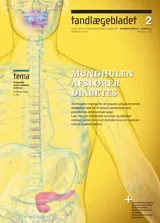Metabolisk syndrom, diabetes mellitus og disse tilstandes betydning for mundhulen
Metabolisk syndrom udgøres af en gruppe insulinresistensmedierede præmorbide tilstande, herunder øget taljemål, triglyceridniveau, blodtryk, fasteplasmaglukose og nedsat mængde high density lipoprotein-kolesterol, der tilsammen øger risikoen for udvikling af diabetes mellitus (DM) type 2 og hjerte-kar-sygdom. Diagnosen metabolisk syndrom, bruges som et screeningsværktøj til prædiktion af ovennævnte sygdomme, og tidlig diagnostik hos egen læge er derfor vigtig, hvis udviklingen af senkomplikationer skal minimeres. DM er den hyppigste endokrine sygdom og omfatter en heterogen gruppe af kroniske metaboliske sygdomme, og de mest prævalente er DM type 1 og 2. Trods forskellige ætiologiske faktorer deler DM type 1 og 2 symptomer, herunder hyperglykæmi, som opstår, såfremt patienternes insulinniveau er insufficient reguleret og medfører en række senfølger i form af mikro- og makrovaskulære komplikationer, og marginal parodontitis anses nu for at være en senfølge til DM. Behandling af DM tilsigter at normalisere blodglukoseniveauerne, hvilket opnås ved farmakologisk behandling og indlæring af sundhedsfremmende adfærd. Diabetes’ disponerende rolle for marginal parodontitis skyldes hyperglykæmis negative effekt i de gingivale bindevæv og kapillærerne heri, samt et ubalanceret værtsrespons ved kontakt med orale mikroorganismer. Disse forhold reducerer tilsammen vævenes helingspotentiale og modstandsdygtighed over for inflammationsmedieret vævsnedbrydning. Diabetikere oplever oftere xerostomi og Candida albicans infektioner, hvilket kan hænge sammen med nedsat spytflow samt ændring i spyttets sammensætning. Infektionerne kan påvirke den metaboliske balance; derfor er det vigtigt, at disse behandles.
Metabolic syndrome, diabetes mellitus and their impact on oral health
Metabolic syndrome comprises a group of insulin resistance mediated premorbid conditions, including increased waist circumference, triglyceride level, blood pressure, fasting plasma glucose and decreased levels of high density lipoprotein cholesterol. The combined presence of these conditions increases the risk of developing diabetes mellitus (DM) type 2 and cardiovascular disease (CVD). The diagnosis of metabolic syndrome, is used as a screening tool for prediction of DM type 2 and CVD, and early diagnosis by the general practitioner may minimize the development of late complications. DM is the most common endocrine disease, and includes a heterogeneous group of chronic metabolic diseases, and the most prevalent are DM type 1 and 2. Despite different etiologic factors, DM type 1 and 2 share symptoms including hyperglycemia, which occurs when patients’ insulin levels are insufficiently regulated and result in a number of sequelae in the form of micro-and macrovascular complications. Periodontitis is now considered one of the late complications of DM. Treatment of DM aims at normalizing blood glucose levels, which is achieved by medical therapy and education in health-promoting behaviours. The predisposing role of diabetes for development of periodontitis is thought to be due to hyperglycemias’ impairment of the inflammatory reactions as well as changes in the periodontal tissues resulting in predominance of catabolic processes in connective tissue and bone. Diabetic patients are more likely to experience xerostomia and infections, which may be associated with reduced salivary flow and changes in saliva composition. Because infections can affect the metabolic balance infection control is extremely important. Dentists see patients regularly, and body type, smoking habits and oral health may be indicative of need for further investigation. Therefore, closer collaboration between dentists and patients’ general practitioners is essential.


